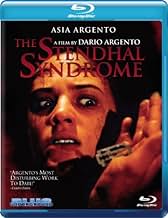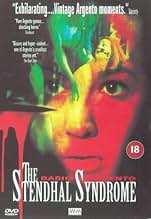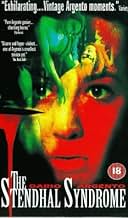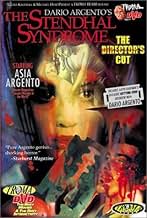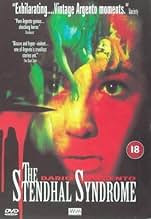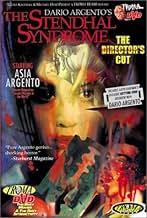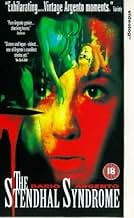CALIFICACIÓN DE IMDb
6.0/10
9.6 k
TU CALIFICACIÓN
Agrega una trama en tu idiomaA young policewoman slowly goes insane while tracking down an elusive serial rapist/killer through Italy when she herself becomes a victim of the brutal man's obsession.A young policewoman slowly goes insane while tracking down an elusive serial rapist/killer through Italy when she herself becomes a victim of the brutal man's obsession.A young policewoman slowly goes insane while tracking down an elusive serial rapist/killer through Italy when she herself becomes a victim of the brutal man's obsession.
- Dirección
- Guionistas
- Elenco
- Premios
- 1 premio ganado y 6 nominaciones en total
Opiniones destacadas
One of the key things in setting up a horror movie for a director has to be mood: if you get your mood right, then you've taken your first step into a larger, more controlled mis-en-scene. Dario Argento is such a bad-ass with mood that one wonders if he comes on to his sets like one of those gunslingers so ready and able that you can feel him draw his eye on a scene in his own way before anyone else can do it so. The mood he sets up, and keeps going on in a disturbing manner, for the Stendhal Syndrome involves a character who we see in the opening scenes walking along in a busy street, go into a museum and just staring at the paintings. But something else is going on: she (Asia Argento) keeps feeling dizzy, looking around mesmerized, not in a good way. She suddenly stares at a painting, feverishly, and sees herself going into the painting itself, in the deep blue ocean of a landscape - and then she awakes, not sure where she was before in the museum. A man comes to help her outside since she left her purse behind, but is this man who he says he...
OK, Argento can take it from here. This is a story that may, in fact, be more disturbing than his films from the 1970s. This doesn't mean it's quite as unforgettable or masterful - a few little things and a couple of potential big things keep it from greatness - but it's never less than interesting as part of Argento canon. One of the things to notice is that, unlike in the past, Argento isn't interested this time in fetishizing the aspect of the "mystery killer" throughout the film. On the contrary, the killer is right out in the open, a truly, brilliantly insane rapist-killer played by Thomas Kreutschman, who helps Asia outside the museum... but then returns when she's on the phone with him (one of those awesome "JUMP" scares when he sort of magically appears in the room), and rapes and beats her. Argento likes this actor in the role, and he's so effective in that we hate him so much and can't wait to see his just desserts gotten.
The other interesting thing is the treatment of the protagonist in this very (psychologically-speaking) twisted Giallo - in part due to the casting. Some may be able to get past the fact that this is Argento's daughter in the lead (originally, to give the benefit of the doubt, Bridget Fonda was cast and then backed out), and he puts her through some grueling things; aside from the obvious (scenes of rape and nudity and some brutal violence), there's the plunging deep into the scarring of a woman who already has a truly surreal disease not unlike an obscure comic-book hero. These are some of the freakiest scenes I've ever seen in any movie, if one can apply 'freaky' here which it should be: seeing her fall into these paintings, the faces of the sculptures, make it about the horror of the abstract intruding in on life, and these are quite creative. The other thing is how far Asia Argento goes into her sickness after the halfway point, when we think things should be getting better following a horrific encounter and the aftermath.
It's a performance that Asia is game for, and she gives it her all, even when things turn into those ludicrous beats one can see from time to time in Dario's movies. One short scene I loved was when Anna is putting on her make-up, slowly, taking her time, putting on her blonde wig (a Hitchcock touch?) while the buzzer is going off frantically and the Ennio Morricone score- as usual a variation on a great theme- plays on. One of the things that ends up making it tolerable of what the father is putting his daughter through here is that it's such a ballsy movie in typical Giallo clothing, reevaluating true evil vs true psychosis. It's only exploitive in certain little things that stick out, such as the silly CGI shot of the pill going down the throat (unnecessary) or the bullet going through the head or with the slow-motion reflection of the killer on the sheen of the bullet. And there are story things that seem a little too simple to bare on first thought, like how quickly Anna bags a guy whom she genuinely is attracted to and doesn't tell him a thing until a certain day when... well, you'll get the idea.
Sure, we've seen the detective-plot stuff, and sure the acting isn't all around very good all of the time save for its two main leads. But when its director gets going with something, it's still invigorating and cringe-worthy a lot of the time. My face when watching this film was a series of slack-jawed pauses and upturned eyebrows. It's gory and flamboyantly directed and it's a hell of a mind-f***, but it works, ultimately, and even underrated.
OK, Argento can take it from here. This is a story that may, in fact, be more disturbing than his films from the 1970s. This doesn't mean it's quite as unforgettable or masterful - a few little things and a couple of potential big things keep it from greatness - but it's never less than interesting as part of Argento canon. One of the things to notice is that, unlike in the past, Argento isn't interested this time in fetishizing the aspect of the "mystery killer" throughout the film. On the contrary, the killer is right out in the open, a truly, brilliantly insane rapist-killer played by Thomas Kreutschman, who helps Asia outside the museum... but then returns when she's on the phone with him (one of those awesome "JUMP" scares when he sort of magically appears in the room), and rapes and beats her. Argento likes this actor in the role, and he's so effective in that we hate him so much and can't wait to see his just desserts gotten.
The other interesting thing is the treatment of the protagonist in this very (psychologically-speaking) twisted Giallo - in part due to the casting. Some may be able to get past the fact that this is Argento's daughter in the lead (originally, to give the benefit of the doubt, Bridget Fonda was cast and then backed out), and he puts her through some grueling things; aside from the obvious (scenes of rape and nudity and some brutal violence), there's the plunging deep into the scarring of a woman who already has a truly surreal disease not unlike an obscure comic-book hero. These are some of the freakiest scenes I've ever seen in any movie, if one can apply 'freaky' here which it should be: seeing her fall into these paintings, the faces of the sculptures, make it about the horror of the abstract intruding in on life, and these are quite creative. The other thing is how far Asia Argento goes into her sickness after the halfway point, when we think things should be getting better following a horrific encounter and the aftermath.
It's a performance that Asia is game for, and she gives it her all, even when things turn into those ludicrous beats one can see from time to time in Dario's movies. One short scene I loved was when Anna is putting on her make-up, slowly, taking her time, putting on her blonde wig (a Hitchcock touch?) while the buzzer is going off frantically and the Ennio Morricone score- as usual a variation on a great theme- plays on. One of the things that ends up making it tolerable of what the father is putting his daughter through here is that it's such a ballsy movie in typical Giallo clothing, reevaluating true evil vs true psychosis. It's only exploitive in certain little things that stick out, such as the silly CGI shot of the pill going down the throat (unnecessary) or the bullet going through the head or with the slow-motion reflection of the killer on the sheen of the bullet. And there are story things that seem a little too simple to bare on first thought, like how quickly Anna bags a guy whom she genuinely is attracted to and doesn't tell him a thing until a certain day when... well, you'll get the idea.
Sure, we've seen the detective-plot stuff, and sure the acting isn't all around very good all of the time save for its two main leads. But when its director gets going with something, it's still invigorating and cringe-worthy a lot of the time. My face when watching this film was a series of slack-jawed pauses and upturned eyebrows. It's gory and flamboyantly directed and it's a hell of a mind-f***, but it works, ultimately, and even underrated.
Argento's main concern as a filmmaker is always with the camera, because for him, the camera is not only something that is used to record the action, but is a constant representation of the eye. This notion is even more important than ever before with The Stendhal Syndrome (1996), Argento's bizarre and brutal thriller, in which an inexplicable affliction pertaining to the relationship between art and the viewer is used as a springboard to a peculiar concoction of murder, rape, identity crisis and pure, psycho-sexual dread.
The story is typical of Argento, with some wonderful references to the classic Giallo style of storytelling found in his earlier films, such as The Bird with the Crystal Plumage (1970), Four Flies on Grey Velvet (1971) and Deep Red (1975), with the continual juxtaposition between the initial police investigation and elements of amateur sleuthing, and all within the broader "stalk and slash" universe of masked killers, wandering point-of-view shots and black leather gloves. However, this is in direct contrast with the incredible viciousness presented by Argento and directed primarily at the central character, in this instance, the young female police investigator, Anna Manni. The treatment of the violence and, in particular, the sexual violence, goes way beyond the brutality of even Tenebrae (1982) or Opera (1988), as the filmmaker attempts to invade a limited psychological space - both in terms of the story and in the visual presentation - that is much deeper and more sinister than anything Argento had done before or since.
The plot here is broken up into two very distinct halves; with the first half showing our protagonist in pursuit of a vicious serial killer who uses her affliction to ensnare her, and the second half showing the breakdown in Anna's personality following a prolonged and violent encounter with the murderer himself. The two different strands are handled well by Argento, with the first half showing his revived interest in the conventions of the Giallo and the second half demonstrating his interest in psychological issues familiar from the masterwork Tenebrae and the largely forgettable American-set thriller Trauma (1993).
There's also a greater attempt to create something approaching reality here, with none of the vivid colours of films like Suspria (1977) and Inferno (1980) or the bravura camera movements or elements of fragmented shot-construction found in Tenebrae and Deep Red. The film points the way forward to subsequent projects, Sleepless (2000) and The Card Player (2005), the latter of the two being something of a thematic sequel to the film in question (though really, this idea makes little to no sense when considered within the context of this film's climax). As bold and different as this presentation is, it must be said that the switch in style isn't entirely successful. There are still a number of slight flaws to the film that we will come back to, but really, it is the occasional drop in quality or the seemingly unbelievable elements of the plot that jar somewhat against the two very distinct and different worlds that the director is trying to create. This still doesn't stop the film from being the best thing that Argento directed in the 90's, and his most enjoyable film overall since Opera almost ten years before.
For me, Sleepless is still the best thing he's directed in the last twenty years, but The Stendhal Syndrome has plenty going for it, even if the abstract concept at the heart of the film may be too outlandish for many to accept. Although there are plot holes and the usual poor dubbing/listless performances, the film makes some valid points about the relationship between art and those that view it, and the always fascinating notions of sight and perception (the things we see and things we feel). Not a masterpiece for certain, but one that regardless offers an interesting idea and some truly thrilling moments of terror and dread.
The story is typical of Argento, with some wonderful references to the classic Giallo style of storytelling found in his earlier films, such as The Bird with the Crystal Plumage (1970), Four Flies on Grey Velvet (1971) and Deep Red (1975), with the continual juxtaposition between the initial police investigation and elements of amateur sleuthing, and all within the broader "stalk and slash" universe of masked killers, wandering point-of-view shots and black leather gloves. However, this is in direct contrast with the incredible viciousness presented by Argento and directed primarily at the central character, in this instance, the young female police investigator, Anna Manni. The treatment of the violence and, in particular, the sexual violence, goes way beyond the brutality of even Tenebrae (1982) or Opera (1988), as the filmmaker attempts to invade a limited psychological space - both in terms of the story and in the visual presentation - that is much deeper and more sinister than anything Argento had done before or since.
The plot here is broken up into two very distinct halves; with the first half showing our protagonist in pursuit of a vicious serial killer who uses her affliction to ensnare her, and the second half showing the breakdown in Anna's personality following a prolonged and violent encounter with the murderer himself. The two different strands are handled well by Argento, with the first half showing his revived interest in the conventions of the Giallo and the second half demonstrating his interest in psychological issues familiar from the masterwork Tenebrae and the largely forgettable American-set thriller Trauma (1993).
There's also a greater attempt to create something approaching reality here, with none of the vivid colours of films like Suspria (1977) and Inferno (1980) or the bravura camera movements or elements of fragmented shot-construction found in Tenebrae and Deep Red. The film points the way forward to subsequent projects, Sleepless (2000) and The Card Player (2005), the latter of the two being something of a thematic sequel to the film in question (though really, this idea makes little to no sense when considered within the context of this film's climax). As bold and different as this presentation is, it must be said that the switch in style isn't entirely successful. There are still a number of slight flaws to the film that we will come back to, but really, it is the occasional drop in quality or the seemingly unbelievable elements of the plot that jar somewhat against the two very distinct and different worlds that the director is trying to create. This still doesn't stop the film from being the best thing that Argento directed in the 90's, and his most enjoyable film overall since Opera almost ten years before.
For me, Sleepless is still the best thing he's directed in the last twenty years, but The Stendhal Syndrome has plenty going for it, even if the abstract concept at the heart of the film may be too outlandish for many to accept. Although there are plot holes and the usual poor dubbing/listless performances, the film makes some valid points about the relationship between art and those that view it, and the always fascinating notions of sight and perception (the things we see and things we feel). Not a masterpiece for certain, but one that regardless offers an interesting idea and some truly thrilling moments of terror and dread.
Regarded as one of Argento's lesser works, I find this one much more plausible than any of his early films. Let's face it, Argento doesn't care much about plot or even acting. His films are probably the frustrating I've ever seen: There are things I love, and things I hate about them. I grew up watching much of his films mutilated by Italian Television. I was a kid back then, and strangely enough his films never scared me when they were supposed to. They were really over the top. But I loved the colours, the pictures and once in a while I found myself humming Claudio Simonetti's electronic scores.
Now with this film Argento has Morricone, who is definitely a master and he does a great job here. Anna's character is really intriguing. Some people dismiss Asia's acting style, but I think it goes very well with her father's aesthetics. You wont find the crazy colours here. Everything is more restrained. The opening for example scene is great. But the film looses interest towards the end. Still I think is one of Argento's most solid pieces. The idea is truly interesting and Anna's relationship with the killer is fascinating. The hallucinations scenes of Anna going into the paintings are masterfully done.
After the huge disappointment of Il Cartaio, I hope he truly returns to form, and start doing what he's good at: Going crazy with film. La Sindrome Di Stendhal is a pretty good step.
Now with this film Argento has Morricone, who is definitely a master and he does a great job here. Anna's character is really intriguing. Some people dismiss Asia's acting style, but I think it goes very well with her father's aesthetics. You wont find the crazy colours here. Everything is more restrained. The opening for example scene is great. But the film looses interest towards the end. Still I think is one of Argento's most solid pieces. The idea is truly interesting and Anna's relationship with the killer is fascinating. The hallucinations scenes of Anna going into the paintings are masterfully done.
After the huge disappointment of Il Cartaio, I hope he truly returns to form, and start doing what he's good at: Going crazy with film. La Sindrome Di Stendhal is a pretty good step.
What makes up the singular pleasure that is Dario Argento? Maybe it's the crossroads where High Romanticism and hardcore porn meet. (I'm referring to the feeling of his work--not the images.) Argento seems doomed, like Peckinpah and like Lynch, to have summed up his world-view in a single masterpiece, the 1977 SUSPIRIA; the thrillers that came before and the low-budget shockers that came after may offer delights, but nothing close to that unity of vision.
Seeing THE STENDHAL SYNDROME projected in Los Angeles, I was struck with newfound sympathy for the Star Wars fans protesting way too much in favor of THE PHANTOM MENACE. If you love THE STENDHAL SYNDROME, you love Argento, and that is that--you may see the flaws, but they don't ruin your pleasure. The picture has too many Achilles heels to enumerate here, but what's important is that nobody in world cinema today is wrestling with his soul in the psychosexual mire the way Argento does. He puts his misogynistic demons and his almost sentimental compassion right out there; and only Cronenberg has such a direct pipeline to his own unconscious. Not to mention the fabulous, cascading images--Argento's stock-in-trade is Victorian Liebestod, Edward Gorey gone porno, and THE STENDHAL SYNDROME has sequences that rank with his best.
The sketchy thing about STENDHAL SYNDROME, like the maestro's TRAUMA, is his use of his daughter, Asia Argento, in scenes one cannot imagine a father watching, much less filming. Whatever memoirs come down the pike twenty years later, it must be said: Argento for certain lets it all hang out, and the land-mined terrain he maps is, to my taste, thrilling.
Seeing THE STENDHAL SYNDROME projected in Los Angeles, I was struck with newfound sympathy for the Star Wars fans protesting way too much in favor of THE PHANTOM MENACE. If you love THE STENDHAL SYNDROME, you love Argento, and that is that--you may see the flaws, but they don't ruin your pleasure. The picture has too many Achilles heels to enumerate here, but what's important is that nobody in world cinema today is wrestling with his soul in the psychosexual mire the way Argento does. He puts his misogynistic demons and his almost sentimental compassion right out there; and only Cronenberg has such a direct pipeline to his own unconscious. Not to mention the fabulous, cascading images--Argento's stock-in-trade is Victorian Liebestod, Edward Gorey gone porno, and THE STENDHAL SYNDROME has sequences that rank with his best.
The sketchy thing about STENDHAL SYNDROME, like the maestro's TRAUMA, is his use of his daughter, Asia Argento, in scenes one cannot imagine a father watching, much less filming. Whatever memoirs come down the pike twenty years later, it must be said: Argento for certain lets it all hang out, and the land-mined terrain he maps is, to my taste, thrilling.
Dario Argento is one of my all-time favorite directors, and probably THE living director I admire the most. The 1990s were a weak decade for Horror in general, and also Argento's weakest. Argento is a cinematic genius, however, and while 90s achievements get nowhere near the brilliance of his masterpieces from the 70s and 80s, films like "Trauma" (1993) or this "Stendhal Syndrome" are nonetheless more than decent Thrillers that outshine the majority of 90s Horror outings.
"La Sindrome Di Stendhal" aka "The Stendhal Syndrome", which was made in-between "Trauma" and the disappointing "Il Fantasma Dell'Opera" (1998), is certainly one of his lesser films, but definitely a more than decent, very suspenseful, atmospheric and often quite weird psychological Horror effort that his fans cannot afford to miss. I like it about equally as I do "Trauma", with a slight preference for "The Stendhal Syndrome" due to the brilliant score by Ennio Morricone. What I found a bit strange is that the film is often labeled as a Giallo, when it is not really. There are no stylishly bloody murders from the killer's perspective, and really what makes the term "Giallo" quite out of place is the fact that the killer's identity is not really a mystery. The suspense is there, however, and most true Horror fans will agree that Argento is the absolute master of suspense. While the film is not quite as exceptionally gory as many other Argento flicks, it is definitely violent, especially the several rape-scenes (one of them taking place quite in the beginning) are more than a bit brutal.
Argento reportedly first wanted to get Bridget Fonda and Jenifer Jason Leigh for the leading role in the film, but his beautiful daughter Asia Argento is, as far as I am considered, the perfect cast for the role. She may look a little too young for an experienced female homicide detective, but she fits the character of her role perfectly, and, as far as I am considered, that is most important. Asia plays detective Anna Manni, a Rome investigator specialized on sex crimes, who is trying to track down a serial rapist and murderer... I do not want to give any more of the plot away. The rest of the performances are also quite good, especially the German actor Thomas Kretschmann delivers a good performance, but Asia Argento sure is the highlight. The film is quite different to Argento's other films, but certainly not bad. None other than the great Ennio Morricone delivers a brilliant and immensely eerie score that intensifies the creepy atmosphere, and, as it is always the case with Argento's films, the film is visually stunning and highly suspenseful.
Dario Argento's masterpieces are his films from the 70s and 80s, and he returned to old greatness in 2001, with the ultra-violent and greatly old-fashioned Neo-Giallo "Non Ho Sonno" (aka. "Sleepless"), which was made in brilliant Argento-tradition. His 90s outings are certainly a bit inferior to the rest of his brilliant repertoire, but they are nonetheless way above average. While it is one of lesser films, "The Stendhal Sydrome" is nevertheless a suspenseful, atmospheric and highly recommendable film with some downright ingenious elements that Horror lovers should definitely not miss. Highly recommended!
"La Sindrome Di Stendhal" aka "The Stendhal Syndrome", which was made in-between "Trauma" and the disappointing "Il Fantasma Dell'Opera" (1998), is certainly one of his lesser films, but definitely a more than decent, very suspenseful, atmospheric and often quite weird psychological Horror effort that his fans cannot afford to miss. I like it about equally as I do "Trauma", with a slight preference for "The Stendhal Syndrome" due to the brilliant score by Ennio Morricone. What I found a bit strange is that the film is often labeled as a Giallo, when it is not really. There are no stylishly bloody murders from the killer's perspective, and really what makes the term "Giallo" quite out of place is the fact that the killer's identity is not really a mystery. The suspense is there, however, and most true Horror fans will agree that Argento is the absolute master of suspense. While the film is not quite as exceptionally gory as many other Argento flicks, it is definitely violent, especially the several rape-scenes (one of them taking place quite in the beginning) are more than a bit brutal.
Argento reportedly first wanted to get Bridget Fonda and Jenifer Jason Leigh for the leading role in the film, but his beautiful daughter Asia Argento is, as far as I am considered, the perfect cast for the role. She may look a little too young for an experienced female homicide detective, but she fits the character of her role perfectly, and, as far as I am considered, that is most important. Asia plays detective Anna Manni, a Rome investigator specialized on sex crimes, who is trying to track down a serial rapist and murderer... I do not want to give any more of the plot away. The rest of the performances are also quite good, especially the German actor Thomas Kretschmann delivers a good performance, but Asia Argento sure is the highlight. The film is quite different to Argento's other films, but certainly not bad. None other than the great Ennio Morricone delivers a brilliant and immensely eerie score that intensifies the creepy atmosphere, and, as it is always the case with Argento's films, the film is visually stunning and highly suspenseful.
Dario Argento's masterpieces are his films from the 70s and 80s, and he returned to old greatness in 2001, with the ultra-violent and greatly old-fashioned Neo-Giallo "Non Ho Sonno" (aka. "Sleepless"), which was made in brilliant Argento-tradition. His 90s outings are certainly a bit inferior to the rest of his brilliant repertoire, but they are nonetheless way above average. While it is one of lesser films, "The Stendhal Sydrome" is nevertheless a suspenseful, atmospheric and highly recommendable film with some downright ingenious elements that Horror lovers should definitely not miss. Highly recommended!
¿Sabías que…?
- TriviaThe opening scene was shot inside the famous Uffizi Gallery in Florence. As of 2014, Dario Argento is the only director who's ever received permission to film inside the museum.
- ErroresThough featuring prominently during the film's opening sequence set at the Uffizi in Florecne, Peter Bruegel's 'Landscape with the Fall of Icarus' is actually housed at the Royal Museum of Fine Arts of Belgium in Brussels.
- Citas
Insp. Manetti: You're young. I can trust you.
- Versiones alternativasUS DVD release by Troma release is the complete version of the English language edition, but, like all English releases, is still missing around 2 minutes of material exclusive to the Italian print.
Selecciones populares
Inicia sesión para calificar y agrega a la lista de videos para obtener recomendaciones personalizadas
Detalles
Taquilla
- Presupuesto
- USD 3,800,000 (estimado)
- Tiempo de ejecución2 horas
- Color
- Mezcla de sonido
- Relación de aspecto
- 1.85 : 1
Contribuir a esta página
Sugiere una edición o agrega el contenido que falta



